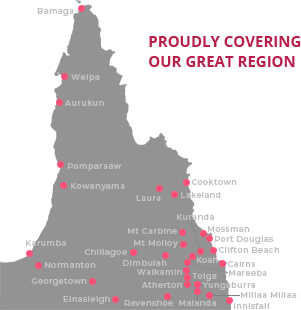General News
8 October, 2025
Spring brings snake season
SOME of the deadliest snakes in the country are found in our region and with an increase in activity due to the return of the warm weather, it is important to stay snake safe.

There are over 40 species of snakes found in Tropical North Queensland, many being some of the deadliest in the country – including the coastal taipan and eastern brown snake.
“At this time of year, we often see an increase in reptile and snake activity associated with the warmer weather, but that’s not the only thing causing snakes to be active,” Tablelands Snake Catchers’ Leslie Brown said.
“Spring is the peak of breeding activity for many snake species and males are out actively looking for mates.
“This means that they move across open areas, through yards and gardens, and cross roads in pursuit of love.
“Outside the breeding season though, most snakes that are commonly found around homes are looking for food, water, or shelter.
“Most of the species people see are rodent hunters, like carpet pythons and eastern brown snakes. So controlling foods and shelter available for rodents goes a long way to remove the interest for snakes.”
Mr Brown said it was important to learn to live with snakes, as they play an important role in maintaining the balance in the natural environment.
“Along with other reptiles, snakes make up a significant proportion of the middle-order predators that keep natural ecosystems working,” he said.
“Without them, the numbers of prey species would increase to unsustainable levels and the predators that eat snakes would struggle to find food.
“All snakes are protected under the Nature Conservation Act 1992 and it is an offence to kill, injure, or take snakes from the wild.
“All snakes usually prefer to retreat when encountered, but if they feel threatened, they can become defensive. Some species like eastern brown snakes have a distinctive warning display, and if they continue to feel threatened, they will bite.
“Many snake bites are received by people who don’t see the snake and step on it, come into close contact with it, or try to capture or kill the snake.”
Tableland Snake Catchers is a locally owned business offering snake removal and damage mitigation services for problematic wildlife, as well as public education services across the Tablelands.
They service the Tablelands, including Ravenshoe, Herberton, Millaa Millaa, Malanda, Yungaburra, and all outlying areas of the Tablelands Regional Council.
They are available 24/7 for snake removals and can be contacted on 0473 169 779, 0498 438 912, or via email at tablelandsnakecatchers@yahoo.com.
For further information, visit their Facebook page at Tableland Snake Catchers.
What to do if you encounter a snake:
Don’t panic.
Move back and away to a safe distance and allow the snake to move away.
If the snake is inside, call a licensed snake catcher.
Snakes often want to escape when disturbed. There is no need to “hurry it along” when left alone, snakes present no danger to people.
Tips to stay snake safe:
Stop snakes entering your home by screening doors and windows and blocking all potential entry points.
Never interfere with snakes. They will defend themselves. A high proportion of snakebites have resulted from people trying to handle, interfere with, or kill snakes.
Always ensure that timber piles are neatly stacked preventing shelter for rodents and snakes. Place food scraps in closed compost bins to make sure that rodents aren’t attracted to your home.
What to do if someone is bitten by a snake:
If you or someone else is bitten by a snake, it is a medical emergency. Immediately contact 000, 112 if there is no reception, or the Royal Flying Doctor Service on 1300 697 337.
Lay the casualty down. Apply a pressure immobilisation bandage. Then apply a broad pressure bandage over the bite site as soon as possible.
Then apply a further elasticised or firm bandage – start at fingers or toes and move up the limb as far as can be reached. Apply tightly but without stopping blood flow.
Ensure the bandage passes over the snakebite, and as far up the inflicted limb or area as possible. Splint the limb including the joints on either side of the bite. If you don’t have a bandage handy, any stretchy material will do.
Once the bandage is on, mark the bite site on the bandage with a pen or other substance that will leave a mark – like mud or dirt.
Ensure the patient remains still. Record the time the bite occurred and when the bandage was applied. Stay with the casualty, monitor and record any changes in their condition, and wait for emergency help to arrive.
(This is a basic guide and should not replace professional medical advice)


